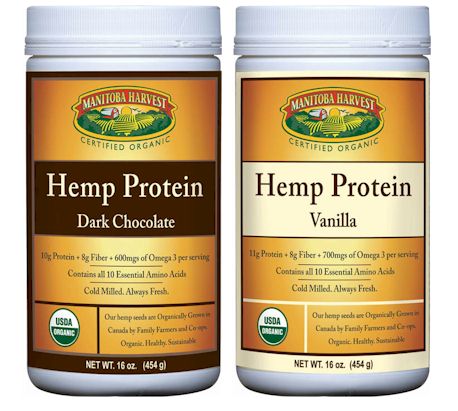What is hemp?
OK, let’s get the Cheech and Chong jokes out of the way immediately.

Hemp is not marijuana.
Although hemp and marijuana are closely related, the hemp plant (botanical name Cannabis Sativa L.), is just one variety of many Cannabis strains (1).
THC (delta-9-tetrahydrocannabinol) is the active substance in pot that gets people high. Hemp crops used today for food and fabric don’t have much of this psychoactive component compared to their partytime cousins.
In Canada and the European Union, only varieties containing less than 0.3% THC in their flowers can legally be farmed, while marijuana flowers typically contain 3 to 20%.
In the U.S., debate over the threat of hemp farming to health and safety keeps the crops pretty much illegal. A license to grow crops can be obtained from the Drug Enforcement Administration, but it’s usually refused. (Ironically, the first U.S. flags were supposedly made from hemp fabric.)
Hemp products you find on the shelves today in the U.S. and Canada come from plants grown mostly in Canada, where farmers have been allowed to grow them since 1998 under the Controlled Drugs and Substances Act.
Hemp uses
Hemp is a versatile plant.
Its fibers, core, seeds and flowers can be used as raw materials to form products ranging from food to paper, and clothing to carpeting.

Hemp is an eco-friendly crop that rarely needs pesticide treatments for bugs or herbicides for weeds (1). Thus, consumers can be assured that hemp foods are low in chemical residues.
Also, many hemp companies certify that their plants contain no Genetically Modified Organisms (GMOs) and/or are grown organically.
Why is hemp so important?
Fatty acid profile
Hemp’s nutritional benefits derive largely from its fatty acid composition (2, 3).
The oil, which makes up half of the weight of the seeds, contains 75% essential fatty acids, of which:
- about 20% are the omega-3, alpha-linoleic acid (ALA)
- about 3% is gamma-linoleic acid (GLA)
- about 1% of the rising omega-3 fatty acid star, stearidonic acid (SDA)

The unique ratio of omega-6 to omega-3 ensures that you can consume hemp without needing to balance it with any other food rich in fat.
The omega-6 to omega-3 ratio of hemp oil is 3:1. This is a good ratio.
Most modern diets are an alarming 10:1, or more. High dietary omega-6s relative to omega-3s is associated with numerous health problems, including cardiovascular disease, cancer, inflammatory and autoimmune diseases (4).
Hemp alone offers benefits that few other foods provide (5).
Vitamin E
Another “fat” property of hemp is that it contains a high content of naturally-occurring vitamin E compounds (tocotrienols and tocopherols) (1, 2, 3).
These free-radical scavenging antioxidants protect the oil from oxidation and rancidity.
Typical levels of vitamin E per 100 grams of hemp oil are about 100 to 150 mg. Therefore, one to two tablespoons of hemp oil meets the daily requirement of vitamin E for healthy adults (dietary reference intake or DRI: 15 mg/day).
Other hemp goodness
The oil of hemp also contains high concentrations of:
- phytosterols, known to have beneficial effects on health;
- chlorophyll, which is shown to be anti-carcinogenic;
- carotenes, necessary for healthy eyesight and growth; and
- lecithin, for cell-membrane composition and brain function (1).
New ways to bump up blood EPA levels: SDA
We usually focus on EPA and DHA fatty acids, found abundantly in cold-water fatty fish and seafood. These fats have numerous cardiovascular and metabolic benefits.
The other omega-3s, such as ALA, are often down-played because they don’t appear to have the same physiological properties as EPA and DHA.
Thus, fish oil is an increasingly popular supplement that people consider a staple of their health regimen. But, as we’ve pointed out here, fish sources are becoming depleted.
The omega-3 fatty acid SDA is now being recognized as another beneficial fat, and is considered a “pro-EPA” fat (6).
In other words, it converts to EPA. Indeed, when humans consume SDA, blood content of EPA in phospholipids can double (7, 8).
SDA is an intermediate in the omega-3 pathway from ALA to EPA (see below), but does not accumulate in blood lipids like ALA (9). So, this special omega-3 fat is converted completely to its downstream products, most importantly EPA (7, 9).
SDA can increase the overall blood omega-3 index, considered to be an important factor for cardiovascular disease (10).
Oils rich in SDA, such as hemp, provide a plant source of SDA.

GLA: Control your weight?
Gamma-linolenic acid, or GLA, is another significant component of hemp (1–6%, depending on species of Cannibis).
GLA is an omega-6 fatty acid that has impacts ranging from inflammation and vascular tone to initiation of contractions during childbirth.
GLA has been found to alleviate psoriasis, atopic eczema, and PMS, and may also benefit cardiovascular, psychiatric, and immunological disorders.
Aging and disease (diabetes, hypertension, etc.) have been shown to impair GLA metabolism, making dietary sources desirable.
GLA supplementation may be helpful for body weight regulation after significant weight loss (11).
Researchers studied obese women who lost a large amount of weight (~60 lbs) and provided them 890 mg of GLA from 5 g of borage oil (to give ~1 g of GLA to each person), or a placebo (olive oil), for one year following weight loss.
The women not receiving the GLA regained over 16 lbs in the subsequent year. Those who received GLA only regained 4 lbs.
The proposed mechanisms for this effect include:
- Increased arachadonic acid (AA) levels in blood lipids due to GLA supplementation. Obese individuals and those with metabolic syndrome usually have lower AA levels in tissue lipids (12, 13). Further, increased AA in blood lipids is related to enhanced lipid sensitivity, down-regulation of lipogenesis (creation of new fat), up-regulation of lipid oxidation, and increased leptin secretion (10, 11).
- Conversion of GLA to its elongation product, DGLA, which has anti-inflammatory effects, via production of beneficial eicosanoids that may operate in weight gain suppression (11).
Hemp oil contains ~450 mg of GLA per tablespoon. To achieve an intake of ~1 g of GLA you need 2 tablespoons per day.
Although you can achieve the same dose of GLA with a smaller dose of borage or evening primrose oil, hemp oil is the only natural food oil that doesn’t require packing into supplement form. Also, it’s a higher-yielding crop that is much easier to cultivate.
Protein
Hemp seeds provide all essential amino acids. The seeds contain 25–35% protein, and some of the hemp protein products today contain as much as 70% protein per 100 grams – similar to whey protein isolate.
The protein in hemp comes from two high-quality storage proteins, edestin and albumin, which are easily digested.
When compared to soy protein isolate, the protein in hemp might actually be superior due to the higher content of some essential amino acids and methionine, cysteine and arginine (14).
Overall, the protein makeup of hemp is highly complete, highly absorbable, and hypoallergenic. It’s also a sustainable and earth-friendly source of amino acids.

Fiber
Hemp fibers are usually saved for production of durable fabrics and specialty papers, leaving the seeds as the food byproduct (1, 14).
Of the whole seeds, about 25% to 50% of the total carbohydrate content is fiber, both insoluble and soluble. Some brands of hemp protein powder even contain up to 14 grams of fiber per serving.
Theoretically, hemp food products could supply a person with all the fiber they need in one day.
What you should know about hemp
The green color of hemp oil, hemp butter, and hemp protein is due to the high content of chlorophyll within the mature seed that is not destroyed during low-temperature processing of hemp foods.
Although this chlorophyll can quicken auto-oxidation of oil exposed to light, as long as the oil is kept in a cold, dark container, this won’t be an issue.
Benefits of chlorophyll in food include protection against several types of cancers, including colon and breast (15). So, when you try your hemp products, know that green is good.
The fruit of hemp is not a true seed, but an “achene”, a tiny nut covered by a hard shell.
Whole hemp seed contains roughly 20-25% protein, 25-35% oil, 20-30% carbohydrates and 10-15% insoluble fiber (1), plus minerals like phosphorous, potassium, magnesium, sulfur, calcium, iron and zinc (2). It’s also a source of carotene, a Vitamin A precursor.

What are the best uses for hemp oil?
Because of the highly unsaturated nature of the oil, it’s extremely sensitive to oxidative rancidity under heat and light. Don’t use the oil for baking or frying. Instead, use hemp as a healthy dipping oil, on salads, or added to smoothies.
What other food products are made from hemp?
The possibilities are endless. Here are some of the most popular food products that you can find readily available in stores today:
- Hemp “milk” – An excellent substitute to rice, soy or cow’s milk. Use as you would on cereal, in smoothies, or straight up.
- Hemp butter – Because it’s not made from a nut, it’s acceptable for those with tree nut allergies. Plus, it tastes great on toasted Ezekiel bread.
- Hemp seeds – Wonderful addition to salads, or simply eaten as a snack.
Summary and recommendations
Hemp foods are under-appreciated, but carry so many health benefits. They’re an earth-friendly way to get more protein, healthy fats and fiber in your diet.
- A tasty, organic, vegetarian/vegan food
- Tolerable by those with nut allergies
- Provides a wide array of omega-3 and 6 fatty acids
- A way to bump up dietary fiber intake
- A protein choice for smoothies and baking
- Supports hemp growing for a healthier, happier planet
Extra credit
Due to the unique fatty acid profile of hemp, it has the power to treat atopic dermatitis in humans.
The seeds are small, soft and round, making them easy to chew and digest. They taste similar to a pine nut.
Hemp protein powder mixes well in water or juice and tastes good.
What’s a tasty hemp smoothie recipe I can make today?
Easy Berry-licious Hemp Smoothie
2/3 cup water
One scoop Hemp Pro 70
1 tbsp hemp seed oil
1/3 cup frozen mixed berries
½ banana
Mix all ingredients in a blender, pour into a cup, and enjoy!
References
Click here to view the information sources referenced in this article.
Learn more
Want to get in the best shape of your life, and stay that way for good? Check out the following 5-day body transformation courses.
The best part? They're totally free.
To check out the free courses, just click one of the links below.




Share